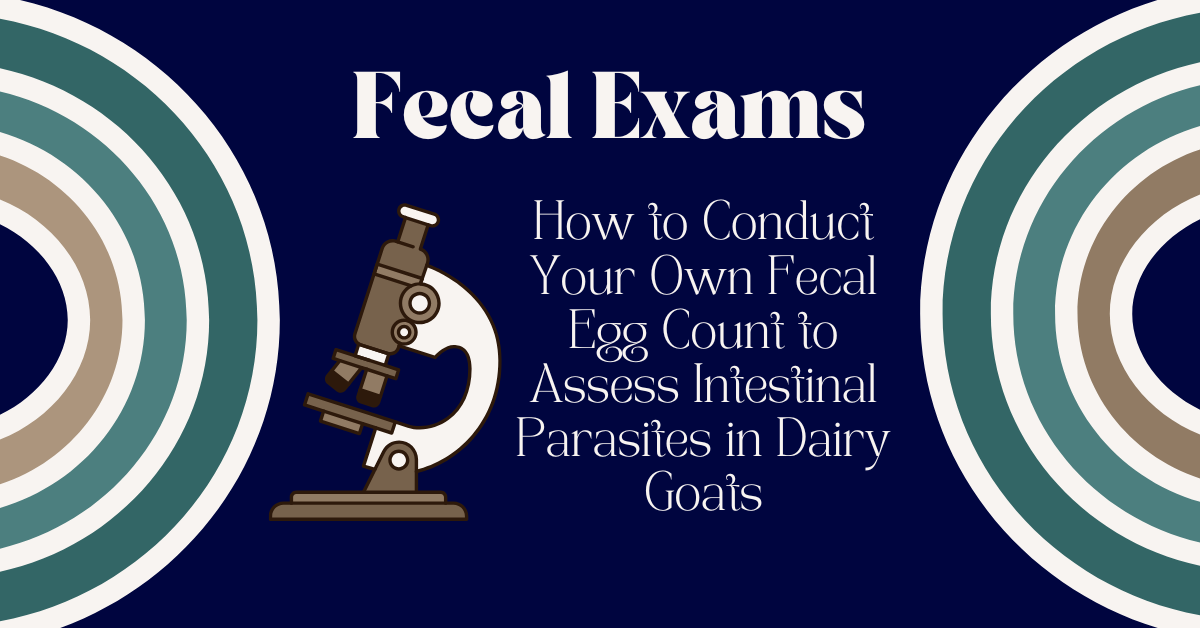How to Conduct Your Own Fecal Egg Count to Assess Intestinal Parasites in Dairy Goats
One of the best ways to monitor the health of your dairy goats and manage internal parasites is through a fecal egg count (FEC). A fecal egg count helps you assess the level of parasite infestation in your goats, giving you the information you need to make informed decisions about their treatment. Doing your own fecal egg count can save time and money, and it’s a valuable skill for any goat owner.
In this blog, we’ll walk you through the process of conducting a fecal egg count and explain why it’s important for managing internal parasites in your herd.
Why Conduct a Fecal Egg Count?
Internal parasites, like Haemonchus contortus (the barber pole worm), Trichostrongylus, and Ostertagia, are common in goats, and they can cause health issues such as weight loss, diarrhea, anemia, and even death if left untreated. However, the signs of parasites aren’t always obvious early on, and goats can often carry a high parasite load without showing symptoms. That’s where a fecal egg count comes in.
By performing a fecal egg count, you can:
- Monitor the parasite load in your goats
- Determine when to treat your goats and avoid unnecessary deworming
- Assess the effectiveness of your deworming protocols
- Help prevent drug resistance by avoiding overuse of dewormers
Materials You’ll Need
To conduct a fecal egg count, you’ll need a few basic materials:
- Fecal sample – You’ll need a fresh fecal sample from your goat. Ideally, collect it within a few hours of defecation to ensure it’s as accurate as possible.
- Fecal flotation solution – You can buy a premade fecal flotation solution or make your own using a combination of water and salt or sugar. The goal is to create a solution with a higher density than the parasite eggs to make them float.
- Fecal egg counting chamber (McMaster slide) – This is a specialized slide with grid markings used to count the eggs. You can find McMaster slides online or through farm supply stores. Maggidans and Eggzamin are a few kit options we’ve used.
- Microscope – A standard light microscope is essential for viewing the eggs clearly. At the Rafter O, we purchased this Microscope from Amazon.
- Gloves and a spoon – To handle the fecal sample and prevent contamination.
Step-by-Step Guide to Performing a Fecal Egg Count
1. Collect the Fecal Sample
The first step is to collect a fresh fecal sample from your goat. You’ll need about one teaspoon of feces, ideally collected directly from the rectum to avoid contamination. Be sure to wear gloves during this step for hygiene purposes.
2. Prepare the Fecal Flotation Solution
If you’re using a pre-made fecal flotation solution, follow the manufacturer’s instructions. If you’re making your own, mix water with salt (or sugar) until it reaches the right density. The solution should be denser than the eggs, causing them to float to the surface.
3. Mix the Sample
Place your fecal sample into a clean container and add a small amount of the flotation solution (around 30-50 ml). Use a spoon to mix the sample thoroughly, making sure the feces are broken up into small particles and suspended in the solution.
4. Fill the McMaster Slide
After mixing, use a pipette to collect a small amount of the liquid and carefully place it onto the McMaster slide. The slide has two chambers that will hold the sample. Fill both chambers with the liquid, ensuring that no air bubbles form.
5. Examine Under the Microscope
Place the slide under the microscope and start with a 10x magnification to get a good view of the sample. Then, increase the magnification to 40x to count the eggs clearly. The goal is to count the number of eggs in each chamber.
6. Count the Eggs
On the McMaster slide, the eggs will appear as tiny oval shapes. Count the number of eggs visible in each of the two chambers. The standard method is to count the eggs in both chambers, and then calculate the total egg count using the following formula:
- Fecal egg count (FEC) = (Number of eggs in both chambers) x 50
For example, if you count 20 eggs in one chamber and 25 eggs in the other, the total egg count would be:
(20 + 25) x 50 = 2,250 eggs per gram of feces (EPG).
7. Interpret the Results
Once you’ve calculated the FEC, you can interpret the results to assess the parasite load. Here’s a general guideline:
- Low (0-500 EPG): Your goat has a low level of parasite infestation and may not require treatment.
- Moderate (500-1,000 EPG): This suggests a moderate level of infestation, and treatment may be needed.
- High (1,000+ EPG): A high fecal egg count indicates a heavy parasite burden, and immediate treatment may be necessary.
What to Do Next?
After interpreting your fecal egg count, take action based on the results:
- If the egg count is high or moderate, consider deworming your goats. Consult your vet for guidance on which dewormers to use and how often to treat, as deworming protocols can vary depending on your location and the specific parasites in your area.
- If the count is low, monitor your goats and repeat the fecal egg count in a few weeks to ensure they remain parasite-free.
- For goats with consistently high fecal egg counts, consider rotating dewormers to avoid resistance and explore alternative parasite management strategies, such as improving pasture management and using herbal dewormers.
Conclusion
Conducting your own fecal egg count is a valuable skill for any dairy goat owner, especially in areas like Texas where internal parasites are a common issue. Regular fecal testing allows you to stay ahead of parasite problems and ensure the health of your herd without overmedicating. By following these simple steps and using the right equipment, you can gain valuable insights into your goats’ health and take the right steps to keep them happy, healthy, and productive.
Happy goat-keeping!




